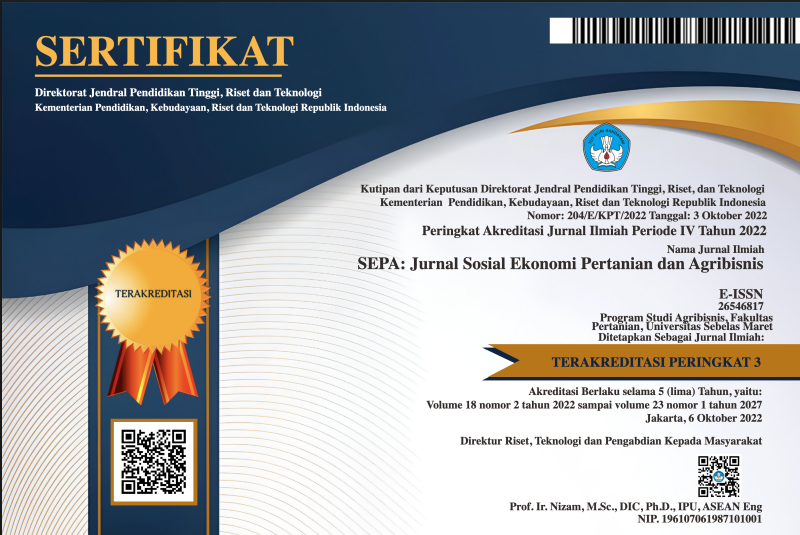STRATEGI PENGEMBANGAN AGRIBISNIS PADI ORGANIK PADA KOMUNITAS PETANI ORGANIK ASTORAHAYU DESA ASTOMULYO, KECAMATAN PUNGGUR, LAMPUNG TENGAH
Abstract
Public demand for rice food has increased while the availability of organic rice is still limited. So that organic rice farming is more promising to be developed. This study aims to determine the agribusiness developing strategy for organic rice in the Astorahayu Organic Farmers Community, Astomulyo Village, Punggur District, Central Lampung Regency. The analytical methods used are IFE, EFE, IE, Analysis of Strengths, Weaknesses, Opportunities, Threats (SWOT), and Analytical Hierarchy Process (AHP). The analysis results showed that the IFE matrix's weight is 2.70, and the EFE matrix is 2.35. The IE matrix is in a hold and maintains position with a market penetration strategy and product development. SWOT analysis produces 12 alternative strategies that can be applied for organic rice expansion. The AHP results show that the level of criteria are the main priority in developing organic rice are increasing marketing and institutionalization with a weight of 0.301. At the objective level, the primary importance of developing the organic rice agribusiness system is expanding the production capacity of organic rice with a weight of 0.508. At the actor level, the farmer in the Astorahayu organic paddy community with a weight of 0.435. The primary priority alternative strategy is to improve the skills of organic rice cultivation by utilizing the cooperation of the organic farming community members to increase productivity with a weight of 0.183.
Keywords
Full Text:
PDFReferences
Alamsyah, D. P. (2014). Metode Analytical Hierarchy Process: Sistem rekomender database software. Jurnal Informatika, 1 (2), 1–15.
Aminah, M. (2017). Strategi pengembangan usaha padi organik bersertifikat berkelanjutan di Kabupaten Tasikmalaya [Disertasi]. IPB, Bogor.
Andriansyah, A. (2019). Analisis strategi pengembangan tanaman hias (Floriculture) di Desa Siraman Kecamatan Pekalongan Kabupaten Lampung Timur [Skripsi]. STIPER Dharma Wacana, Metro.
Aziz, I. J. (2010). Pembangunan Berkelanjutan: Peran dan Kontribusi Emil Salim. Jakarta: Gramedia Pustaka Utama.
Balitbangtan. (2010). Peta Potensi Penghematan Pupuk Anorganik dan Pengembangan Pupuk Organik pada Lahan Sawah Indonesia. Jakarta: Badan Penelitian dan Pengembangan Pertanian.
David, F. R. (2006). Manajemen Strategis Konsep. Edisi Sepuluh. Jakarta: Salemba Empat.
Ifada, I. I., & K. N. (2016). Faktor eksternal dan internal dalam upaya pengembangan agribisnis padi organik. Al Ulum Sains dan Teknologi, 2(1), 1–5.
Jamison, R. J., & Perkins, J. H. (2010). The History of Organic Agriculture. in: Rosemeyer M, Gliessman SR, Editor. The Conversion to Sustainable Agriculture; Principle, Process and Practices. New York: CRS Press Taylor & Francis Group.
Jumna, B. K. (2015). Strategi pengembangan usahatani dalam upaya peningkatan produksi padi organik. Economics Development Analysis Journal (EDAJ), 4(2), 233–241.
Lestari, A. P. (2009). Pengembangan pertanian berkelanjutan melalui substitusi pupuk anorganik dengan pupuk organik. Jurnal Agronomi, 13(1), 38–44.
Permadi, B., & Brojonegoro, B. (1992). AHP Pusat Antar Universitas, Studi Ekonomi. Jakarta: UI.
Rai, N. (2018). Dasar-Dasar Agronomi. Denpasar: Pelawa Sari.
Research Institute of Organik Agriculture (FIBL). (2018). International Federation of Organic Agricultural Movement. Frick, Switzerland: FIBL.
Saaty, T. L. (1993). Pengambilan Keputusan Bagi Para Pemimpin, Proses Hirarki Analitik Untuk Pengambilan Keputusan dalam Situasi Yang Kompleks. Jakarta: PT Pusaka Binaman Pressindo.
Safitri, S. A., Chalil, D., & Emalisa. (2014). Strategi pengembangan sistem agribisnis beras organik. Journal of Agriculture and Agribusiness Socioeconomics, 2(10), 1–15.
Sucihatiningsih, D. & Waridin. (2010). Model penguatan kapasitas kelembagaan penyuluh pertanian dalam meningkatkan kinerja usahatani melalui transaction cost. Jurnal Ekonomi Pembangunan, 11(1), 13–29.
DOI: https://doi.org/10.20961/sepa.v18i2.49713
Refbacks
- There are currently no refbacks.



.png)







.png)
3.png)





